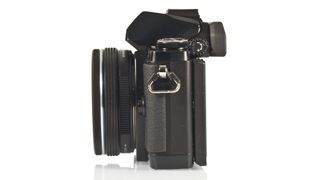TechRadar Verdict
An excellent camera that affords lots of control over images, feels good in the hand and has a control layout that's easy to get to grips with. It also has a healthy number of customization options and produces high quality images.
Pros
- +
High quality EVF
- +
Excellent image quality
- +
Compact metal body
Cons
- -
Tilting rather than vari-angle screen
- -
Not weather-sealed
- -
No battery-grip
Why you can trust TechRadar
Olympus is hoping that the new OM-D E-M10 will find favor in the same way as the OM-10 did when it was launched way back in 1979.
Whereas the OM-10 was the first consumer-level camera in Olympus's OM series of SLRs, and went on to be a big hit and a popular choice for family photography, the Olympus E-M10 is the first consumer-level model in the highly respected OM-D series. It sits below the Olympus OM-D E-M5 and Olympus OM-D EM-1 in the company's line-up of Micro Four Thirds compact system cameras.
For those unsure of the difference, the Olympus OM-D series distinguishes itself from the Pen series (Olympus Pen E-PM2, Pen E-PL5 and Pen E-P5) by its more SLR-like styling and the presence of a built-in electronic viewfinder (EVF).
Features
Many of the features found in the E-M10 are the same as in the Olympus E-M5, the original OM-D – the Four Thirds type (17.3x13mm) 16.1-million-pixel LiveMOS sensor and 1,440,000-dot electronic viewfinder, for example.
This means that unlike the E-M1's sensor there is an optical low-pass filter present. However, rather than using the TruePic VI engine of the E-M5, Olympus has used the TruPic VII processor that is found in the top-end OM-D E-M1.
The TruPic VII processor incorporates Fine Detail II Technology that adapts processing to the characteristics of individual lenses and aperture settings. It is also claimed to allow better noise control. These two features may mean that the new E-M10 could produce better quality images than the E-M5.
This processor also allows sensitivity to be set in the range ISO 100-25,600 and a maximum continuous shooting rate of 8fps – although focus and exposure are locked at the start. In addition, shutter speed may be set in the range 1/4000-60sec (plus bulb) and exposure compensation can be adjusted to +/-5EV.

As the E-M10 uses the E-M5's sensor it doesn't have the phase detection pixels of the E-M1, so focusing is carried out by contrast detection alone. A total of 81 AF points are available for selection at normal viewing sizes, which can be selected individually or in groups of nine.
Focus modes
In addition to Single AF mode, Continuous AF mode, Manual Focus (MF), Single AF + MF and AF Tracking mode are available. Manual Focus is aided by the ability to magnify specific areas of the scene and focus peaking, which highlights the areas of highest contrast.
Face Detection AF is also available and this can be augmented with Eye Detect AF, Left, Right and Near side priority.
While it's the entry-level OM-D camera, the E-M10 still has the enthusiast friendly exposure modes: program, aperture priority, shutter priority and manual. There's also a healthy collection of automatic scene modes (24 in total), including a new Hand-Held Starlight mode. In this mode the camera captures eight images and automatically combines them into a single composite for better exposure and noise control.

In addition to Olympus's standard Live Bulb and Live Time modes, which allow the photographer to see the image build-up on the screen during long exposures, there's a new option called Live Composite Lighten Mode. This allows a reference image of the background to be recorded with a short exposure before the shutter is opened for a second time. It closes again when you press the shutter release for a third time after the image has built-up on the camera's screen. Live Composite mode is intended for use when shooting fireworks or light trails to produce better dynamic range and avoid backgrounds from burning out during long exposures. If there's nothing lighter than the reference image in the long exposure scene, the image will not change.
Filter modes
Being an Olympus camera, the E-M10 has a large collection of Art Filter modes – 19 in total – which may be used to apply an effect to images. Many of these effects are customisable. They can be applied to JPEG files and video clips, but raw files can also be recorded at the same time so there's a 'clean' image for processing.
Like the other OM-D cameras, the E-M10 has a tilting LCD screen that is touch-sensitive for making settings adjustments and swiping through images in review mode. This is a 3-inch device with 1,370,000 dots like the E-M1's, so it trumps the E-M5 screen's 610,000 dot-count.

Key differences in comparison to the E-M5 include a simplification of the optical stabilisation system, which is 3-axis rather than 5, no battery-grip compatibility, the lack of an accessory port in the hotshoe and no weather-sealing.
The 3-axis stabilisation counteracts yaw, roll and pitch for both still shots and HD movies, irrespective of the lens attached to the camera. It is claimed to extend the safe hand-holdable shutter speed by up to 3.5EV.
Pop-up flash
A small pop-up flash, with Guide Number 5.8m at ISO 100, is a key addition to the E-M10. This will be useful for fill-in or shooting in low-light conditions. As mentioned earlier, there's also a hotshoe to accept an external flash. While the built-in flash sync speed is 1/250sec, it is 1/200sec with an external flashgun (1/180sec with the FL-50R).
The new camera also has Wi-Fi connectivity built-in, the same system as in the E-M1. Furthermore, it's compatible with the updated Olympus Image Share app which gives extensive control over camera settings, even allowing the exposure mode to be set to something other than the option indicated by the camera's mode dial. It's also possible to use a smartphone like a standard wireless remote shutter and just trip the shutter, keeping the camera settings as they are set on the body.

On the face of it, the E-M10 looks like an attractive alternative to the E-M5. It has many of the same features, makes only a few compromises and has a few aspects borrowed from the top-end E-M1.
Olympus has announced a new 14-42mm f/3.5-5.6 EZ lens to complement the E-M10 and it will be offered as the standard kit lens. This new lens is a powerzoom and it collapses down when the camera is turned off to maintain the slim lines of the camera. Olympus claims that it is the slimmest standard zoom lens in the world.

